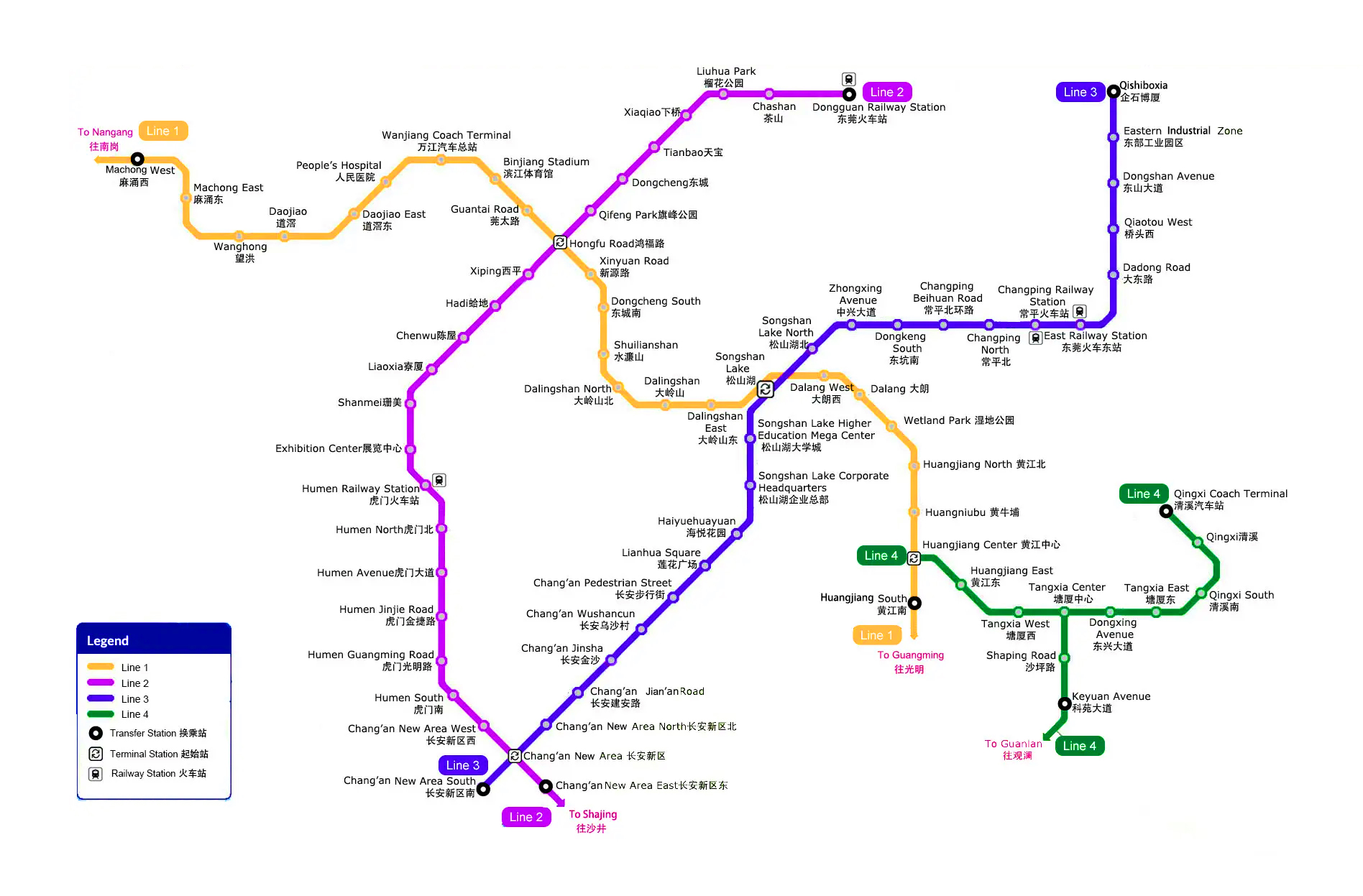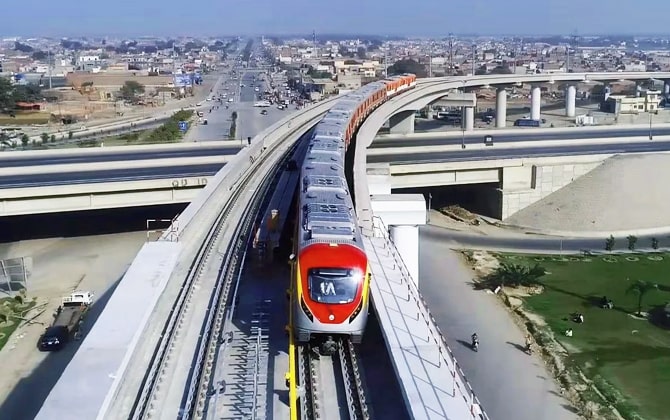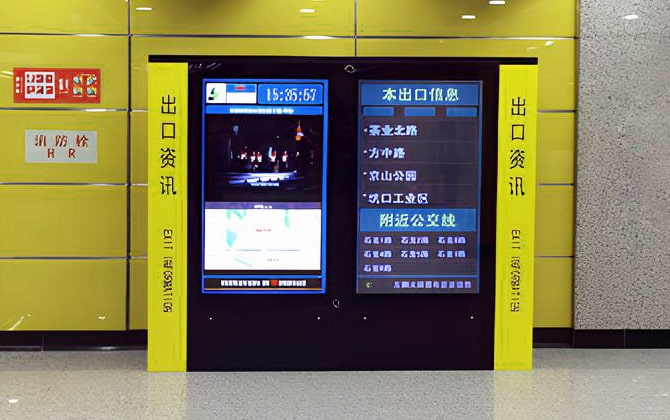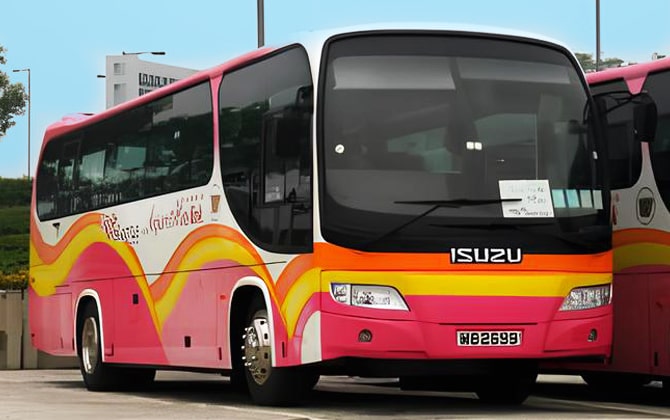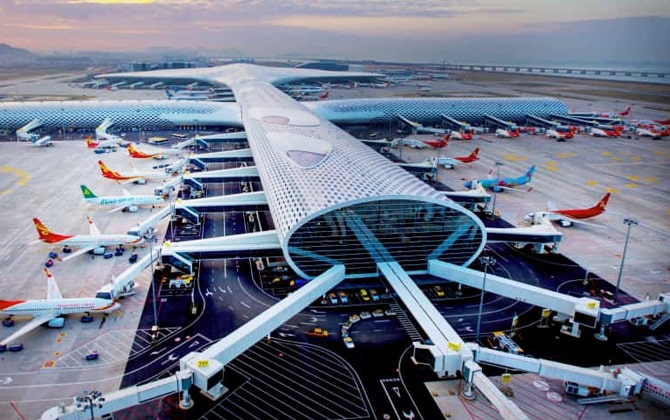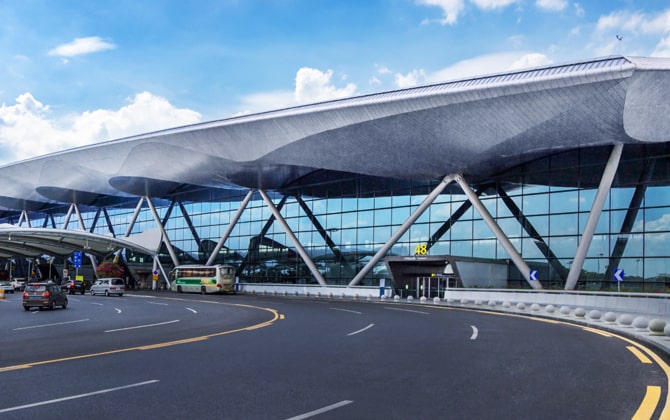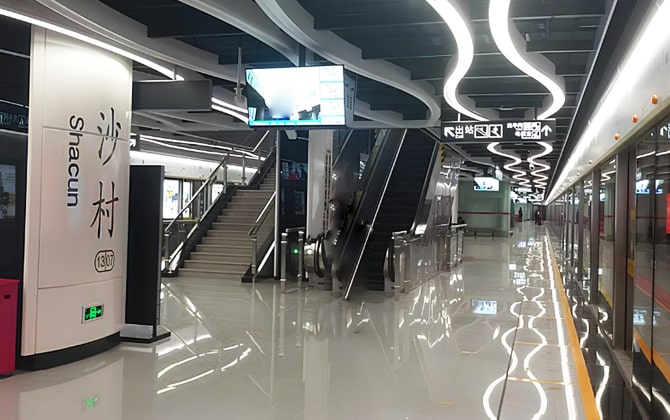Dongguan Rail Transit (Dongguan Metro) serves Dongguan city in Guangdong Province, China. Its first line (Line 2) opened on May 27, 2016, spanning 37.7 km (23.4 mi) between Humen Railway Station and Dongguan Railway Station with 15 stops. As of 2026, Line 2 remains the only operational line, but the network is rapidly expanding. The master plan includes 7 total lines covering approximately 308 km by 2030. Lines 1 and 3 are under construction with expected completion around 2026, while Lines 4-7 are in various planning stages. The system integrates with regional transport networks, connecting to the Guangzhou–Shenzhen intercity railway at Humen Station, providing convenient links to neighboring metropolises.
Dongguan Metro is managed by the state-owned Dongguan Rail Transit Corp. Line 2 has already helped reduce congestion along the Pearl River Delta by connecting key towns including Shilong, Chashan, Dongcheng, Nancheng, Houjie, and Humen.
The system features modern trains with platform screen doors, security screening at entrances, and bilingual signage. Ridership continues to grow steadily as the Metro provides safe, air-conditioned transport for both commuters and visitors.
All stations and trains have CCTV surveillance and staff on duty. No major safety incidents have been reported. Standard rules apply: no hazardous items, stand behind safety lines, allow passengers to exit before boarding, and mind the platform gap.
Most stations offer convenient bus and taxi connections. Many accept the Dongguantong transit card, which works on buses and provides a 10% fare discount.
Dongguan Metro Map (2026)
Current Dongguan Metro map show Line 2 in red, running northeast from Humen to Dongguan Station. The network planning map indicates all seven proposed lines with their routes and interchange stations.
Line 2’s 15 stations are clearly marked, with terminal symbols at both Humen and Dongguan Railway stations.
Click on the map to enlarge it or download the Dongguan Metro map in PDF format.
Dongguan Metro Lines and Stations
Line 2 (Humen Line)
The only line currently in operation (red). It spans 37.743 km (23.45 mi) from Humen Railway Station (虎门火车站) in Humen Town to Dongguan Railway Station (东莞火车站) in Shilong Town. Since opening in 2016, it serves 15 stations. Key stops include Humen (regional rail interchange), Shanmei, Hongfu Road, and Dongguan metro Station terminus.
Line 2 Phase III Extension
Currently under construction, this 17.1 km (10.6 mi) southern extension will add 9 new stations. It will continue south from Humen toward downtown Humen area with expected completion around 2027.
Line 1
Under construction. Phase I includes 21 stations covering 57.5 km (35.7 mi) from Wanghong (north) to Huangjiang Center (south). Projected opening: 2026. Phase II will extend westward from Dongguan West station into Guangzhou’s Huangpu New Port, connecting with Guangzhou Metro Line 5.
Line 3
In planning stages with Phase I set to include 20 stations spanning 51.5 km (32.0 mi) between Jiaoyiwan (south) and Dongguan East Station (northeast). Construction schedule has not been publicly announced.
Line 4
Planned as a Y-shaped line with 12 stations and three termini: Huangjiang Center (interchange with Line 1), Qingxi Coach Terminal, and Guanguang Road. The Huangjiang–Qingxi segment is prioritized, though no firm start date has been announced.
Line 5
Planned to run from Dongguan East (near Humen) through Fenggang Town to Dongguan South (Fenggang South).
Line 6
Planned route from Dongguan Railway Station to the Xiegang area in northern Dongguan.
Line 7
Planned to connect Dongcheng (central Dongguan) and Zhongtang (northeast).
Dongguan Metro Schedule & Timetable
Operating Hours Today
Line 2 runs daily with first trains departing around 06:30 from both termini and final trains between 22:30-23:00. On weekdays, the first trains leave Dongguan Station and Humen Station at 06:30.
The last train departs Dongguan Railway Station for Humen at 22:30 (Monday-Thursday) or 23:00 (Friday-Sunday). Similarly, the final train from Humen to Dongguan leaves at 22:30 or 23:00, depending on the day.
Weekend and holiday Dongguan metro schedule are slightly extended, typically running until 23:00. Special schedules may apply during festivals or major events such as Spring Festival.
Opening and Closing Times
Line 2: First trains depart at 6:30 AM from both Dongguan Railway Station and Humen Railway Station. Last trains leave between 10:30-11:00 PM, varying by day of week.
Future Lines (including Line 1): Will likely follow similar 06:30-23:00 schedules when operational, which is standard for Chinese metro systems. Official hours will be announced upon launch.
Frequency & Train Schedule
During peak hours (weekdays 07:00-09:00 and 17:00-19:00), Line 2 trains run approximately every 6-8 minutes. Off-peak and weekend service operates every 10 minutes.
The complete journey from Dongguan Railway Station to Humen takes about 40 minutes.
Typical Line 2 Dongguan metro timetable pattern:
- First trains (both directions): ~06:30
- Last trains: ~22:30-23:00
- Peak intervals: every 6-8 minutes
- Off-peak intervals: every 10 minutes
Dongguan Metro Ticket Prices & Fares
Fare Structure
Dongguan Metro uses distance-based pricing. As of 2026, one-way fares are:
- CNY 3 (~USD 0.40) for trips up to 4 km (2.5 miles)
- CNY 4-7 (~USD 0.55-0.98) for distances of 4-12 km (2.5-7.5 mi)
- CNY 7-9 (~USD 0.98-1.26) for 12-24 km (7.5-15 mi)
- For trips exceeding 24 km (15 mi), an additional CNY 1 (~USD 0.14) applies for each 8 km
Typical single-ride fares range from ¥3 to ¥8 ($0.40 to $1.10). A full journey across Line 2 costs CNY 8. The exact fare is automatically calculated upon exit.
Fare Calculator
Dongguan Metro uses a distance-based system without zones. Quick reference chart:
- 0-4 km: ¥3
- 4-12 km: ¥4-7
- 12-24 km: ¥7-9
- Beyond 24 km: +¥1 per 8 km
Currency conversion (2026): ¥1 ≈ $0.14 USD
Ticket Types and Day Pass
Single Journey Ticket: QR code ticket (paper token) valid for one trip. Available at Dongguan Metro ticket machines or via mobile payment at gates.
Stored-Value Card (Dongguantong): Rechargeable smart card usable on both metro and city buses. Tap at entry and exit for automatic fare deduction. Offers a 10% discount on subway fares.
Mobile Payment: Most stations accept mobile QR code payment options (WeChat Pay, Alipay) and NFC options (Samsung Pay, Apple Wallet with Chinese transit cards).
Concessions: Children under 1.2 meters (approximately 4 feet) ride free. Senior citizens (60+) typically receive half-price fares, and student discounts may apply with valid ID.
Day Pass: Dongguan Metro currently doesn’t offer unlimited day passes. Use stored-value cards or QR tickets for multiple rides.
How Much Does Dongguan Metro Cost?
Dongguan Metro uses a distance-based fare system. Below is the fare structure for Line 2 (Humen ↔ Dongguan, 37.7 km or 23.4 mi):
| Distance | Fare (CNY) | Approx. USD |
|---|---|---|
| 0–4 km (0–2.5 mi) | ¥3 | ~$0.40 |
| 4–12 km (2.5–7.5 mi) | ¥4–7 | ~$0.55–0.98 |
| 12–24 km (7.5–15 mi) | ¥7–9 | ~$0.98–1.26 |
| Over 24 km | +¥1 per 8 km | +$0.14 per 5 mi |
Traveling the full length of Line 2 costs ¥8 (~$1.10). Using a Dongguantong card reduces this to ¥7.2 with the 10% discount.
Routes and Connections
Connections with Dongguan Bus and Airport
Dongguan Bus Network: The city has an extensive bus system covering all towns and suburbs. Most metro stations have adjacent bus stops with multiple routes. For example, Humen Station connects with city buses L1, L3, L7, and several express lines.
Bus fares are very affordable, typically ranging from ¥1–12 (~$0.14–$1.68) depending on distance, with most local trips costing around ¥2 (~$0.28). Five special “Tourist” bus lines (L1–L5) serve popular districts and parks, with fares from ¥1 to ¥12.
Airport Connections: Dongguan has no airport of its own. The nearest airports are:
- Shenzhen Bao’an International Airport (approximately 60 km/37 mi south)
- Take Dongguan Metro Line 2 to Humen Station
- Transfer to the Guangzhou–Shenzhen intercity railway at adjacent Humen North station
- High-speed commuter trains run to Shenzhen Airport (journey ~2 hours, ¥21–¥35 or ~$2.94–$4.90)
- Guangzhou Baiyun International Airport (approximately 80 km/50 mi north)
- Currently: Take Line 2 to Humen, then intercity train to Guangzhou Xintang and transfer to Guangzhou Metro
- Future: The Guangzhou–Shenzhen intercity line will extend north through Dongguan to Guangzhou Baiyun Airport
- The planned Xinbaiguang intercity extension will eventually connect Humen directly to Guangzhou North/Baiyun Airport
Additionally, buses run from Dongguan to both Shenzhen and Guangzhou city centers. High-speed intercity rail and planned connections with Guangzhou/Shenzhen metros will further integrate Dongguan with the region.
Dongguan Public Transport Overview
Besides the metro, Dongguan offers:
- City Bus: Hundreds of routes link all neighborhoods and satellite towns. Buses operate from approximately 6:00–22:00 in most areas, with extended hours for major routes. Multiple payment methods are accepted (cash, IC cards, mobile pay).
- Rail and Intercity: Dongguan is served by the Guangzhou–Shenzhen Intercity Railway (stations at Humen and Dongguan West) and the Guangzhou–Shenzhen–Hong Kong Express Rail Link (via Dongguan Railway Station). These provide rapid travel to Guangzhou, Shenzhen, and Hong Kong.
- Taxis and Rideshare: Metered taxis and app-based services (Didi) are widely available. Flag-down fare is about ¥10 ($1.40) plus ¥2–3 ($0.28–$0.42) per kilometer.
- Bike/Bikeshare: Public bikeshare and e-bike services are common near transit hubs, useful for “last-mile” travel.
- Cross-Border: For travelers to Hong Kong/Macau, shuttle buses and intercity trains connect via neighboring Shenzhen/Guangzhou lines.
Public transit in Dongguan is integrated via the Dongguantong card, which works for both metro and buses. Efforts are underway to improve transfers and unified payment across the Greater Bay Area.
Facilities & Services
Parking Charges per Day
Many Dongguan Metro stations provide Park-and-Ride or nearby parking lots. Parking fees vary by location. Typical rates:
- Small cars: ¥5–10 ($0.70–$1.40) for the first hour, then roughly ¥2 ($0.28) for each additional hour
- Large vehicles: Slightly higher rates (e.g., first hour ~¥10 or $1.40)
There is usually no one-day flat rate – parking is charged hourly. Some lots may cap daily fees at around ¥20–30 ($2.80–$4.20), but this varies by location. Many drivers use adjacent private lots or shopping center parking (which often offer 2 hours free with purchase) rather than station-owned lots.
Always check signage at each location for current rates.
Dongguan Metro Card – How to Use
The Dongguantong (东莞通) card is the city’s rechargeable transit smartcard. It can be purchased and loaded at metro station service counters or vending machines.
To use it:
- Tap In/Out: Touch the card to the fare gate reader when entering and exiting the Metro (also works on buses). The correct fare is automatically deducted.
- Discount: Card users receive a 10% discount on subway fares.
- Top-Up: Add value via station vending machines or designated retail outlets. Some banks and convenience stores also support recharging.
- Balance: Displayed on gate screen when you tap. Maintain at least ¥5–10 on the card for travel.
- Refund: Unused deposit (if any) can be refunded at customer service counters.
Many riders now use mobile payment: you can link the Dongguantong card to WeChat/Alipay, or use those apps’ built-in transit pay feature to tap your phone at the gates.
Rules & Useful Tips for Riding
Safety: Dongguan Metro is safe and well-maintained. Security screening (bag X-ray) is mandatory at all station entrances. Stay behind the yellow safety line while waiting. Trains and platforms are monitored by CCTV. Emergency intercoms and help points are available throughout stations.
Etiquette:
- Stand to the right on escalators to let others pass on the left
- Let passengers exit the train before boarding
- Move to the middle of the car to make room
- Priority seats for elderly, pregnant, disabled, or those with young children should be offered when needed
Boarding: Wait behind the marked arrow outlines on the platform. Do not block doors.
Prohibited: No smoking, eating, drinking, or carrying flammable/hazardous items (including aerosol cans, gas cylinders). Loud music or disturbances are not allowed. Violators may face fines.
Accessibility: All stations have elevators. Wheelchair spaces are available on trains. Children under 1.2 meters (3.9 feet) ride free but must be accompanied.
Tips for First-Time Users: Plan your route in advance. Signs display both Chinese and English station names. Station staff generally speak basic English. Keep your ticket/card until after you exit. Have exact change or payment card ready when buying tickets (typically ¥3–9 or $0.42–$1.26).
Rush Hour: Prepare for crowds on Line 2 during peak commute times. Avoid standing near doors if possible and hold onto handrails. Wear comfortable shoes as platforms can be long.
Customer Service: Lost-and-found, inquiries, and card issues are handled at station service centers (usually near exits). Emergency phone numbers are posted throughout stations.
Interesting Facts & History
Early Planning: Dongguan’s metro was first proposed in the early 2000s. An initial 2004 plan envisioned approximately 195 km of network with 55 stations by 2020. In reality, the first phase was scaled back to ~60 km (Line 2 phases I & II), which received approval in 2009.
Line 2 Opening: Dongguan became one of the last major Pearl River Delta cities to open a metro. The Humen–Dongguan line (37.7 km/23.4 mi) opened in May 2016, relieving highway congestion and linking Dongguan to the fast rail network.
Technology: The Metro uses modern Chinese-standard rolling stock. Future Line 1 is designed for speeds up to 120 km/h (75 mph) – faster than typical metro systems – to enable rapid cross-city travel.
Integration: Dongguan Metro is unique in being part of a multi-city system. Line 1 Phase 2 will cross into Guangzhou at Huangpu New Port, and Shenzhen Lines 12/18 will eventually link with Line 2 at Humen. These inter-regional connections highlight Dongguan’s role in the Greater Bay Area rail network.
Ridership Growth: Since 2016, Line 2 has carried tens of millions of riders in a city of approximately 10 million people. Fares (¥2–8 or $0.28–$1.12) are among the lowest in China. Despite its limited extent, Line 2 has significantly improved travel along the busy Humen–Shilong corridor.
Historical milestones:
- 2009: National Development and Reform Commission approves Dongguan’s first phase (37.8 km/23.5 mi)
- 2015: Trial operations of Line 2 begin
- 2016: Line 2 opens (May 27)
- 2024: Line 1 completes full track laying and enters final system testing phase, targeting 2026 opening
- Future: Line 2 Phase 3 construction (started 2022) aims for ~2027 opening
Future Expansions & Upcoming Lines
Dongguan’s metro network is expanding rapidly:
Line 2 Phase III: Currently under construction (started August 2022). This 17.1 km (10.6 mi) extension with 9 stations will extend Line 2 deeper into Humen Town, serving the new town center. Expected opening: approximately 2027.
Line 1 Phase I: The 57.5 km (35.7 mi) Wanghong–Huangjiang Center segment is in late construction stages, with tunnels and viaducts completed. Trial runs are planned, with revenue service likely beginning in 2026.
Line 1 Phase II: Planning is underway to extend Line 1 west from Dongguan West into Guangzhou at Huangpu New Port. This will allow one-transfer journeys between Dongguan city and central Guangzhou. Environmental assessments for the Guangzhou segment (~0.9 km/0.56 mi) were announced in late 2024.
Line 3 (Phase I): Planned as a 51.5 km (32 mi) line between Jiaoyiwan and Dongguan East with 24 stations. Early-stage planning is ongoing, though construction dates have not yet been announced. When completed, Line 3 will link northern Songshan Lake (Changping) with eastern Chang’an.
Line 4: This Y-shaped line (12 stations) is in the planning stages. The main branch will run from Huangjiang to Qingxi with a branch to Guanguang, enhancing north-south coverage in central/eastern Dongguan. Construction schedule remains to be announced.
Lines 5–7: These are in long-term planning (targeted for completion by 2030):
- Line 5: Dongguan East – Fenggang South
- Line 6: Dongguan Station – Xiegang
- Line 7: Dongcheng – Zhongtang
The city is also studying further extensions to integrate with Shenzhen and Guangzhou metro systems. For example, a southern extension of Line 4 beyond Qingxi has been discussed in the 2035 planning documents.
